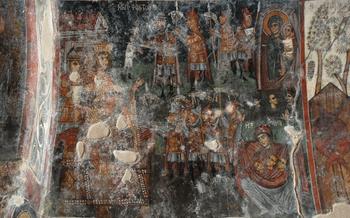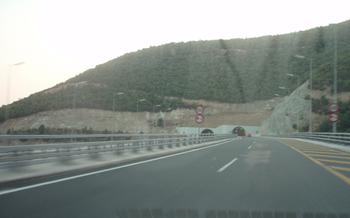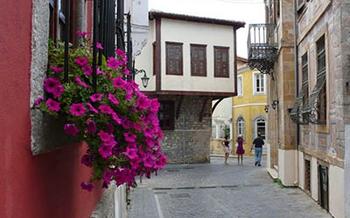
Church of Saint Panteleimon
- The Church of Saint Panteleimon: A Hidden Gem in Thessaloniki
- Location and Accessibility
- Architectural Overview
- Interior Decoration
- Religious Significance
- Cultural Importance
- Visiting Information
- Highlights for Visitors
- Tips for Photography Enthusiasts
- Local Legends and Folklore
- Events and Festivals
- Nearby Attractions
- Accessibility for Differently-Abled Visitors
- Insider Tip: Hidden Courtyard Garden
The Church of Saint Panteleimon: A Hidden Gem in Thessaloniki
The Church of Saint Panteleimon, nestled in the heart of Thessaloniki's historic center, is a hidden gem that captivates visitors with its rich history, stunning architecture, and religious significance. Erected in the 13th century, during the Byzantine era, the church stands as a testament to the city's deep-rooted Christian heritage and its remarkable resilience amidst the tides of time.
Its architectural features, a blend of Byzantine and Ottoman influences, showcase intricate stonework, graceful arches, and a distinctive bell tower that pierces the skyline. The interior is adorned with exquisite frescoes and iconography, transporting visitors to a realm of spirituality and awe. As a sacred site for the Greek Orthodox Church, Saint Panteleimon holds immense religious importance, attracting pilgrims from far and wide who seek solace, blessings, and a connection with their faith.
Location and Accessibility
The Church of Saint Panteleimon is conveniently situated in the heart of Thessaloniki, making it easily accessible to visitors from all corners of the city. Its exact address is 26 Oktovriou Street, placing it within easy walking distance of the bustling city center and other popular tourist attractions.
To reach the church, visitors can take advantage of Thessaloniki's efficient public transportation system. The nearest bus stop, "Agios Panteleimonas," is just a short walk away, connecting visitors to various parts of the city. Alternatively, the church is accessible by taxi or ride-sharing services, providing a convenient option for those who prefer direct transportation.
For those arriving by car, limited street parking is available in the vicinity of the church. However, due to the area's popularity, it is advisable to arrive early or explore alternative parking options to ensure a hassle-free visit.
Architectural Overview
The Church of Saint Panteleimon stands as a testament to the architectural prowess of its builders, showcasing a harmonious blend of Byzantine and Ottoman influences. The exterior facade boasts intricate brickwork, with alternating patterns creating a visually striking effect. The church's layout follows the traditional cruciform plan, with a central dome supported by four massive pillars. The dome, a defining feature of Byzantine architecture, adds a sense of grandeur to the overall structure.
Notable architectural elements include the elaborate portal, featuring intricate carvings and sculptures depicting biblical scenes. The windows, adorned with stained glass, allow natural light to filter into the interior, creating a serene and ethereal atmosphere. The church's bell tower, a later addition, rises proudly above the city skyline, inviting visitors to explore its hidden treasures.
In comparing the Church of Saint Panteleimon to other churches in Thessaloniki, one can appreciate its unique features. While it shares similarities in terms of its cruciform layout and the use of domes, Saint Panteleimon distinguishes itself with its exquisite brickwork and the integration of Ottoman elements, such as the pointed arches and decorative tiles. It is a testament to the rich architectural heritage of Thessaloniki, where different cultures and influences have intertwined to create a diverse and captivating cityscape.
Interior Decoration
The interior of the Church of Saint Panteleimon is a testament to the artistry and devotion of its builders. The walls and ceilings are adorned with exquisite iconography and frescoes depicting scenes from the Bible and the life of Saint Panteleimon. These colorful and detailed paintings are a visual feast, capturing the attention of visitors with their emotive narratives and intricate brushwork.
The church also boasts intricate marble carvings and sculptures, which add a touch of grandeur to the interior. The pulpit, featuring delicate carvings of angels and biblical figures, is a particularly noteworthy example. The iconostasis, the partition separating the sanctuary from the nave, is adorned with intricate carvings and gold leaf, creating a sense of awe and reverence.
Stained glass windows, depicting scenes from the life of Christ and the saints, filter the sunlight, casting a warm and colorful glow throughout the church. The interplay of light and color creates a serene and contemplative atmosphere, inviting visitors to pause and reflect on the sacredness of the space.
The acoustics of the church are also remarkable, contributing to the overall sensory experience. The high ceilings and carefully placed arches create a natural reverberation, enhancing the sound of prayers, hymns, and the chanting of the priests. This acoustic quality adds to the solemnity of religious ceremonies and creates a sense of unity among the congregation.
Religious Significance
The Church of Saint Panteleimon holds great religious importance in Thessaloniki and beyond. It is dedicated to Saint Panteleimon, a renowned healer and martyr in the early Christian era. As the patron saint of physicians, Saint Panteleimon is deeply revered by the Greek Orthodox community. Believers from all over the country flock to the church to seek his intercession and pray for healing.
The church serves as a significant pilgrimage site for Orthodox Christians, who come to venerate the relics of Saint Panteleimon, including a portion of his skull and a vial containing his blood. These relics are believed to possess miraculous powers and have been attributed to numerous healings and divine interventions.
Throughout the year, the Church of Saint Panteleimon hosts various religious ceremonies and events, including daily services, special feast days dedicated to Saint Panteleimon, and processions carrying his relics through the streets of Thessaloniki. These events draw large crowds of faithful who come to celebrate their patron saint and seek his blessings.
Cultural Importance
The Church of Saint Panteleimon stands as a symbol of Thessaloniki's rich heritage, embodying the city's blend of Byzantine and Ottoman influences. Its architectural style, intricate iconography, and religious significance contribute to the city's diverse religious landscape. The church has become an integral part of the local community, serving as a place of worship, pilgrimage, and cultural events.
The integration of Byzantine and Ottoman elements in the church's design reflects Thessaloniki's unique history and cultural crossroads. The Byzantine-style mosaics and frescoes depict biblical scenes and saints, while the Ottoman-inspired domes and minarets add a distinct architectural flair. This harmonious blend of styles showcases the city's ability to embrace and integrate diverse influences throughout its history.
Beyond its religious significance, the Church of Saint Panteleimon holds cultural importance as a venue for various events and exhibitions. The church's spacious interior and serene atmosphere provide an ideal setting for concerts, art exhibitions, and cultural performances. These events not only enrich the city's cultural landscape but also attract visitors from around the world, contributing to Thessaloniki's vibrant cultural scene.
Visiting Information
Before visiting the Church of Saint Panteleimon, it is important to be aware of its operating hours and any admission fees. The church is typically open to the public daily, with specific hours varying depending on the time of year. Admission is usually free of charge, but donations are welcome and support the church's ongoing maintenance and restoration efforts.
Guided tours of the church are available for groups and individuals, providing an opportunity to learn more about its history, architecture, and religious significance. These tours are typically led by knowledgeable guides who can share insights and answer questions. It is advisable to inquire about tour availability and reservations in advance to avoid disappointment.
When visiting the church, it is essential to observe proper etiquette and dress code. Visitors should dress respectfully, with shoulders and knees covered. photography and videography are generally permitted within the church, but it is essential to be mindful of other visitors and avoid using flash photography or tripods.
Highlights for Visitors
The Church of Saint Panteleimon offers a wealth of unique features that captivate visitors from all walks of life. One of its most striking aspects is the exquisite iconography adorning its interior walls and ceiling. These vibrant and intricate paintings depict scenes from the life of Christ, the Virgin Mary, and various saints, showcasing the exceptional artistry and devotion of Byzantine craftsmen.
Within the church complex, visitors can explore the serene courtyard garden, a hidden oasis in the heart of the city. Surrounded by lush greenery, colorful flowers, and shady trees, this tranquil space invites visitors to pause, reflect, and appreciate the beauty of nature. It's an ideal spot to seek solace, escape the urban hustle and bustle, and find a moment of peace and contemplation.
For those interested in delving deeper into the church's history and significance, guided tours are available upon request. Led by knowledgeable experts, these tours provide insights into the church's construction, architectural features, religious importance, and its role in the local community throughout the centuries.
Don't miss the opportunity to explore the church's crypt, which houses the relics of Saint Panteleimon. Believed to possess miraculous healing powers, these relics have drawn countless pilgrims and visitors seeking divine intervention and blessings. The crypt is a sacred space where visitors can pay their respects, offer prayers, and experience a sense of spiritual connection.
Tips for Photography Enthusiasts
The Church of Saint Panteleimon offers a treasure trove of opportunities for photography enthusiasts to capture its architectural grandeur and intricate details. Here are some tips to help you make the most of your photographic experience:
-
Best Angles and Lighting Conditions: The church's exterior is best photographed during the golden hours of sunrise and sunset, when the warm light casts a soft glow on the stone facade. For interior shots, natural light streaming through the stained glass windows creates beautiful patterns and highlights.
-
Capturing the Interior's Intricate Details: The church's interior boasts a wealth of intricate details, from the delicate frescoes to the ornate marble carvings. Use a macro lens or get up close to capture the fine craftsmanship and symbolism hidden within these elements.
-
Avoiding Crowds and Reflections: To avoid capturing unwanted crowds or reflections in your shots, visit the church during quieter times, such as early in the morning or late in the afternoon. Using a polarizing filter can also help reduce reflections from the polished marble surfaces.
-
Tips for Editing and Post-Processing: When editing your photos, consider adjusting the contrast and saturation to enhance the vibrant colors of the frescoes and stained glass windows. Experiment with different editing techniques to bring out the unique character and atmosphere of the church.
Local Legends and Folklore
The Church of Saint Panteleimon is deeply embedded in the local folklore and mythology of Thessaloniki. Stories and myths have been passed down through generations, adding to the church's mystique and allure.
One popular legend tells of a miraculous healing that occurred within the church's walls. A devout believer, who had been suffering from a debilitating illness, prayed fervently to Saint Panteleimon for relief. In a dream, the saint appeared to the individual, promising a cure if they visited the church and drank from its holy water. Upon awakening, the individual followed the saint's instructions and was miraculously healed.
Another tale speaks of a hidden treasure buried beneath the church. According to legend, during the Ottoman occupation, the church's priests hid a vast treasure of gold and jewels within the church's foundations to protect it from being plundered by the invading forces. The treasure is said to be guarded by the spirits of the priests who hid it, ensuring that it remains safe and untouched.
These legends and stories add a layer of enchantment to the Church of Saint Panteleimon, making it not just a religious site but also a place of mystery and wonder.
Events and Festivals
The Church of Saint Panteleimon is not only a place of worship but also a vibrant center for cultural and religious events. Throughout the year, the church hosts a variety of celebrations, festivals, and special events that attract visitors from all over the region.
One of the most significant events is the annual feast day of Saint Panteleimon, which takes place on July 27th. During this day, the church is adorned with flowers and decorations, and a special liturgy is held to honor the patron saint. Pilgrims and locals alike gather to pay their respects and participate in the festivities, which often include traditional music, dancing, and food.
In addition to religious celebrations, the Church of Saint Panteleimon also hosts cultural events and concerts. These events provide a platform for local artists to showcase their talents and share their work with the community. Visitors can enjoy performances of traditional Greek music, Byzantine chant, and modern compositions, as well as exhibitions of art, photography, and sculpture.
Attending events and festivals at the Church of Saint Panteleimon offers a unique opportunity for visitors to immerse themselves in the cultural and spiritual heritage of Thessaloniki. Whether you are interested in religious traditions, music, art, or simply experiencing the vibrant atmosphere of a local celebration, the church has something to offer everyone.
Here are some tips for attending events and festivals at the Church of Saint Panteleimon:
- Check the church's website or social media pages for a calendar of upcoming events.
- Arrive early to secure a good seat, especially for popular events.
- Dress respectfully, as the church is a place of worship.
- Be mindful of the religious significance of the events and behave accordingly.
- Take the opportunity to interact with the locals and learn more about their customs and traditions.
Nearby Attractions
In the vicinity of the Church of Saint Panteleimon, visitors can delve deeper into Thessaloniki's rich history and vibrant culture by exploring neighboring attractions. Just a short walk away, the Church of the Holy Apostles stands as a testament to the city's Byzantine heritage, with its impressive architecture and well-preserved mosaics. History buffs can immerse themselves in the past at the Museum of Byzantine Culture, housing a vast collection of artifacts and artworks from the Byzantine era.
For those seeking artistic inspiration, the State Museum of Contemporary Art showcases a diverse range of modern and contemporary artworks, including paintings, sculptures, and installations. Art enthusiasts can also visit the Thessaloniki Museum of Photography, dedicated to preserving and exhibiting the works of renowned photographers from Greece and beyond.
To experience Thessaloniki's culinary delights, venture into the labyrinthine alleys of the Kapani Market, a bustling marketplace filled with colorful stalls selling fresh produce, spices, and traditional Greek delicacies. Sample local specialties such as bougatsa (custard pie) and loukoumades (honey-doused doughnuts) while soaking up the lively atmosphere.
Shopaholics can indulge in a retail therapy session at Tsimiski Street, the city's main shopping artery, lined with international brands, local boutiques, and souvenir shops. For those seeking unique handmade crafts and artisanal products, the Ladadika District offers a treasure trove of shops and workshops showcasing the talents of local artisans.
Accessibility for Differently-Abled Visitors
The Church of Saint Panteleimon is committed to ensuring accessibility and inclusivity for all visitors, regardless of their physical abilities. The church features wheelchair ramps and designated seating areas to accommodate visitors with mobility challenges. Additionally, audio guides and visual aids are available to assist visitors who are visually or hearing-impaired. The church staff is also trained to provide assistance and guidance to ensure that all visitors have a comfortable and fulfilling experience.
Insider Tip: Hidden Courtyard Garden
Strolling through the bustling city center, few would expect to find a hidden oasis nestled within the Church of Saint Panteleimon. Tucked away behind the main sanctuary, a charming courtyard garden offers a tranquil escape from the urban clamor.
With its secluded location, the garden exudes an air of serenity and peace. Lush greenery, vibrant flowers, and aromatic plants fill the space, creating a captivating sensory experience. Visitors can immerse themselves in the beauty of nature as they stroll along the cobblestone paths and admire the vibrant blooms.
Seating areas are thoughtfully arranged throughout the garden, inviting visitors to linger and savor the tranquility. Whether seeking a moment of contemplation or simply enjoying the company of friends, this hidden gem provides an idyllic setting for relaxation and reflection.
As the seasons change, so too does the garden's appearance. In spring, the courtyard bursts into life with a kaleidoscope of colors as flowers of all hues bloom in abundance. Summer brings a profusion of fragrant roses, while autumn transforms the garden into a tapestry of golden leaves.
This hidden courtyard garden is a testament to the unexpected treasures that can be found in the heart of Thessaloniki. It serves as a reminder that even amidst the hustle and bustle of city life, there are still places where one can find peace, tranquility, and a connection with nature.



